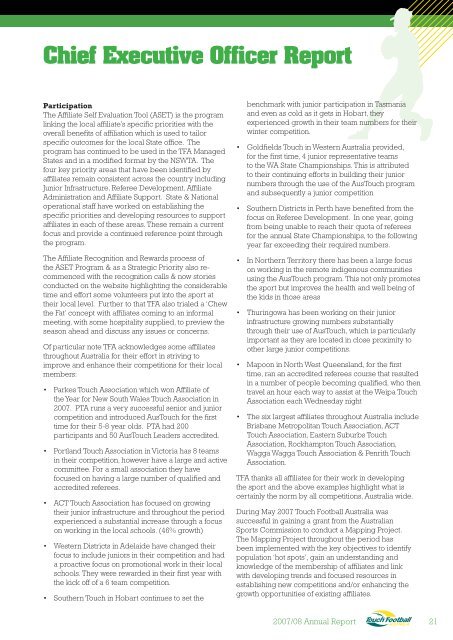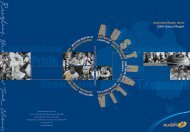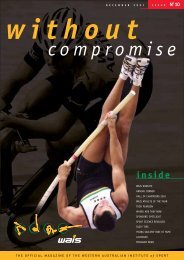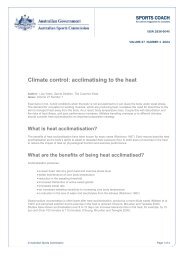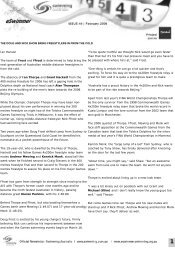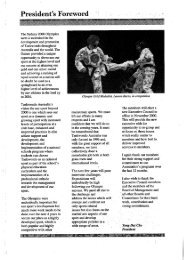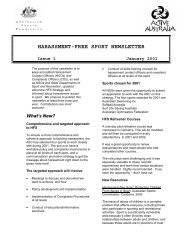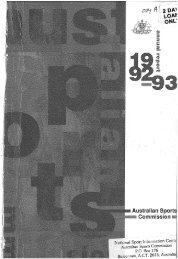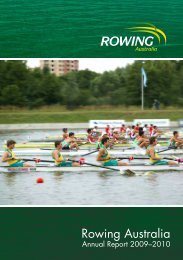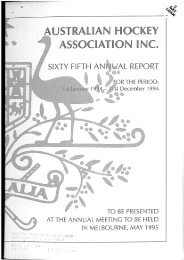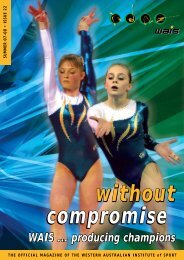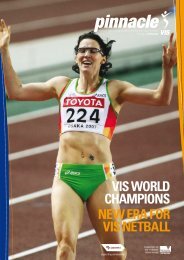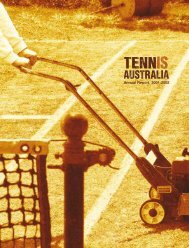Chief Executive Officer Report - Australian Sports Commission
Chief Executive Officer Report - Australian Sports Commission
Chief Executive Officer Report - Australian Sports Commission
Create successful ePaper yourself
Turn your PDF publications into a flip-book with our unique Google optimized e-Paper software.
<strong>Chief</strong> <strong>Executive</strong> <strong>Officer</strong> <strong>Report</strong><br />
Participation<br />
The Affiliate Self Evaluation Tool (ASET) is the program<br />
linking the local affiliate’s specific priorities with the<br />
overall benefits of affiliation which is used to tailor<br />
specific outcomes for the local State office. The<br />
program has continued to be used in the TFA Managed<br />
States and in a modified format by the NSWTA. The<br />
four key priority areas that have been identified by<br />
affiliates remain consistent across the country including<br />
Junior Infrastructure, Referee Development, Affiliate<br />
Administration and Affiliate Support. State & National<br />
operational staff have worked on establishing the<br />
specific priorities and developing resources to support<br />
affiliates in each of these areas. These remain a current<br />
focus and provide a continued reference point through<br />
the program.<br />
The Affiliate Recognition and Rewards process of<br />
the ASET Program & as a Strategic Priority also recommenced<br />
with the recognition calls & now stories<br />
conducted on the website highlighting the considerable<br />
time and effort some volunteers put into the sport at<br />
their local level. Further to that TFA also trialed a ‘Chew<br />
the Fat’ concept with affiliates coming to an informal<br />
meeting, with some hospitality supplied, to preview the<br />
season ahead and discuss any issues or concerns.<br />
Of particular note TFA acknowledges some affiliates<br />
throughout Australia for their effort in striving to<br />
improve and enhance their competitions for their local<br />
members:<br />
• Parkes Touch Association which won Affiliate of<br />
the Year for New South Wales Touch Association in<br />
2007. PTA runs a very successful senior and junior<br />
competition and introduced AusTouch for the first<br />
time for their 5-8 year olds. PTA had 200<br />
participants and 50 AusTouch Leaders accredited.<br />
• Portland Touch Association in Victoria has 8 teams<br />
in their competition, however have a large and active<br />
committee. For a small association they have<br />
focused on having a large number of qualified and<br />
accredited referees.<br />
• ACT Touch Association has focused on growing<br />
their junior infrastructure and throughout the period<br />
experienced a substantial increase through a focus<br />
on working in the local schools. (46% growth)<br />
• Western Districts in Adelaide have changed their<br />
focus to include juniors in their competition and had<br />
a proactive focus on promotional work in their local<br />
schools. They were rewarded in their first year with<br />
the kick off of a 6 team competition.<br />
• Southern Touch in Hobart continues to set the<br />
benchmark with junior participation in Tasmania<br />
and even as cold as it gets in Hobart, they<br />
experienced growth in their team numbers for their<br />
winter competition.<br />
• Goldfields Touch in Western Australia provided,<br />
for the first time, 4 junior representative teams<br />
to the WA State Championships. This is attributed<br />
to their continuing efforts in building their junior<br />
numbers through the use of the AusTouch program<br />
and subsequently a junior competition<br />
• Southern Districts in Perth have benefited from the<br />
focus on Referee Development. In one year, going<br />
from being unable to reach their quota of referees<br />
for the annual State Championships, to the following<br />
year far exceeding their required numbers.<br />
• In Northern Territory there has been a large focus<br />
on working in the remote indigenous communities<br />
using the AusTouch program. This not only promotes<br />
the sport but improves the health and well being of<br />
the kids in those areas<br />
• Thuringowa has been working on their junior<br />
infrastructure growing numbers substantially<br />
through their use of AusTouch, which is particularly<br />
important as they are located in close proximity to<br />
other large junior competitions.<br />
• Mapoon in North West Queensland, for the first<br />
time, ran an accredited referees course that resulted<br />
in a number of people becoming qualified, who then<br />
travel an hour each way to assist at the Weipa Touch<br />
Association each Wednesday night<br />
• The six largest affiliates throughout Australia include<br />
Brisbane Metropolitan Touch Association, ACT<br />
Touch Association, Eastern Suburbs Touch<br />
Association, Rockhampton Touch Association,<br />
Wagga Wagga Touch Association & Penrith Touch<br />
Association.<br />
TFA thanks all affiliates for their work in developing<br />
the sport and the above examples highlight what is<br />
certainly the norm by all competitions, Australia wide.<br />
During May 2007 Touch Football Australia was<br />
successful in gaining a grant from the <strong>Australian</strong><br />
<strong>Sports</strong> <strong>Commission</strong> to conduct a Mapping Project.<br />
The Mapping Project throughout the period has<br />
been implemented with the key objectives to identify<br />
population ‘hot spots’, gain an understanding and<br />
knowledge of the membership of affiliates and link<br />
with developing trends and focused resources in<br />
establishing new competitions and/or enhancing the<br />
growth opportunities of existing affiliates.<br />
2007/08 Annual <strong>Report</strong><br />
2


